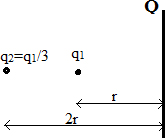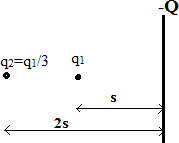
Concept explainers
a. Charge q1is distance r from a positive point charge Q. Charge q2= q1/3 is distance 2r from Q. What is the ratio U1/U2 of their potential energies due to their interactions with Q? b. Charge q1is distance s from the negative plate of a parallel-plate capacitor. Charge q2= q1/3 is distance 2s from the negative plate. What is the ratio U1/U2 of their potential energies?
a. Ratio of potential energy
b. Ratio of potential energy
Answer to Problem 1CQ
Solution:
a. Ratio of the potential energy is
b. Ratio of the potential energy is
Explanation of Solution
Given:
(a)
Charge
Charge
(b)
Charge
Charge
Formula used:
The potential energy of the charge particle is given by the formula
Here,
Calculation:
(a)
Consider the diagram of the charge particles

Figure.1
The potential energy of the charge particle
The potential energy of the charge particle
Plugging the values in the above equation
Calculate the ratio of the potential energy by dividing Eq. (1) by Eq. (2)
Hence the ration of their potential energy is
(b)
Consider the diagram of the charge particles

Figure.1
The potential energy of the charge particle
Plugging the values in the above equation
The potential energy of the charge particle
Plugging the values in the above equation
Calculate the ratio of the potential energy by dividing Eq. (3) by Eq. (4)
Hence the ration of their potential energy is
Conclusion:
a. Ratio of the potential energy is
b. Ratio of the potential energy is
Want to see more full solutions like this?
Chapter 25 Solutions
PHY F/SCIENTIST MOD MASTERING 24 MO
Additional Science Textbook Solutions
Concepts of Genetics (12th Edition)
Laboratory Experiments in Microbiology (12th Edition) (What's New in Microbiology)
Cosmic Perspective Fundamentals
The Cosmic Perspective (8th Edition)
Chemistry: An Introduction to General, Organic, and Biological Chemistry (13th Edition)
Human Anatomy & Physiology (2nd Edition)
- 14. When the potential difference between the plates of an ideal air-filled parallel plate capacitor is 35 V, the electric field between the plates has a strength of 670 V/m. If the plate area is 4.0 × 10^-2 m^2, what is the capacitance of this capacitor in pF? (ε0 = 8.85 × 10^-12 C^2/N ∙ m^2)arrow_forward10. A small styrofoam ball of mass 0.500 g is placed in an electric field of 1140 N/C pointing downward. What excess charge must be placed on the ball for it to remain suspended in the field? Report your answer in micro-Coulombs to three significant figures.arrow_forward2arrow_forward
- Assuming the normal angle for stairs in a house, 37.0˚ with the horizontal, what is Kevin’s acceleration down the stairs? The sled is always touching at least one stair so you can treat it the same as a ramp. The coefficient of kinetic friction between the sled and the carpeted stairs is 0.708.arrow_forwardA helicopter pulls up and back on the truck with a force of 5.78⋅10^4 N at an angle of 30.0˚ from the horizontal. The truck has a mass of 5.04⋅10^3 kg. The truck’s engine applies a force on the truck that is in the x direction causing the truck to accelerate at 2.09 m/s2 in x. A) What is the force the engine is exerting? B) What is the normal force acting on the truck? Assume no acceleration in y.arrow_forwardMikasa and her allies, from Attack on Titan, uses omni-directional mobility gear (ODM gear) to move from place to place. The ODM gear launches out wires with grappling hooks they can use to swing through the city. Mikasa, who has a mass of 68.0 kg, holds herself in place not moving with two wires from the ODM gear, as shown below with θ1 = 39.3°. If the tension in the wire labeled T1 is 688 N, what tension, magnitude and direction, is needed in T2?arrow_forward
 College PhysicsPhysicsISBN:9781938168000Author:Paul Peter Urone, Roger HinrichsPublisher:OpenStax College
College PhysicsPhysicsISBN:9781938168000Author:Paul Peter Urone, Roger HinrichsPublisher:OpenStax College Physics for Scientists and Engineers, Technology ...PhysicsISBN:9781305116399Author:Raymond A. Serway, John W. JewettPublisher:Cengage Learning
Physics for Scientists and Engineers, Technology ...PhysicsISBN:9781305116399Author:Raymond A. Serway, John W. JewettPublisher:Cengage Learning
 College PhysicsPhysicsISBN:9781285737027Author:Raymond A. Serway, Chris VuillePublisher:Cengage Learning
College PhysicsPhysicsISBN:9781285737027Author:Raymond A. Serway, Chris VuillePublisher:Cengage Learning Physics for Scientists and Engineers: Foundations...PhysicsISBN:9781133939146Author:Katz, Debora M.Publisher:Cengage Learning
Physics for Scientists and Engineers: Foundations...PhysicsISBN:9781133939146Author:Katz, Debora M.Publisher:Cengage Learning College PhysicsPhysicsISBN:9781305952300Author:Raymond A. Serway, Chris VuillePublisher:Cengage Learning
College PhysicsPhysicsISBN:9781305952300Author:Raymond A. Serway, Chris VuillePublisher:Cengage Learning





